| Columns Retired Columns & Blogs |
AVM Ovation PA 8.2 modular preamplifier Measurements
Sidebar 3: Measurements
I measured the AVM Ovation PA 8.2 using my Audio Precision SYS2722 system (see the January 2008 "As We See It"). Looking first at the line-level analog inputs on the Tone input module: With the AVM's volume control set to its maximum of "99,5," the maximum voltage gain at 1kHz measured 18.24dB from the solid-state balanced and unbalanced outputs, 18.2dB from the tubed balanced and unbalanced outputs, and 21.85dB from the headphone terminals. The line inputs preserved absolute polarity from all five outputs (ie, were non-inverting), and the unbalanced input impedance was a fairly low 6700 ohms from 20Hz to 20kHz, this doubling as expected for the balanced inputs.
The headphone output impedance was 16 ohms at all audio frequencies. From the solid-state output module, the unbalanced impedance was a usefully low 46.7 ohms, this doubling, again as expected, from the balanced output. The corresponding output impedances from the tubed output module were 45.8 and 91.5 ohms, these also very low, suggesting that there might be a solid-state buffer following the tube section.
The solid-state output module's frequency response is flat up to 20kHz (fig.1), rolling off above the audioband to reach –3dB at 130kHz. The tube output module's response rolled off earlier, reaching –1dB at 20kHz (fig.2). Fig.3 shows the line input and solid-state output's responses with the Treble and Bass controls bypassed, then set to their maximum ("+7") and minimum ("–7"). The Treble control appears to be a conventional Baxandall type, though with a fairly extreme ±13dB action at 20kHz. The Bass control is a bandpass type that boosts or cuts the output at 120Hz by ±12.5dB. The response with the Contour control active (not shown) applies a 13dB bandpass boost centered on 120Hz, and shelves up the high frequencies by 6dB above 5kHz.
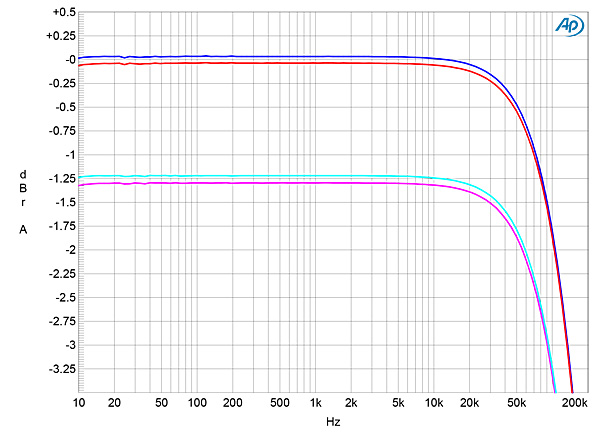
Fig.1 AVM PA 8.2, line input, balanced solid-state output, volume control = "99,5," frequency response at 1V into: 100k ohms (left channel blue, right red), 600 ohms (left cyan, right magenta) (0.25dB/vertical div.).
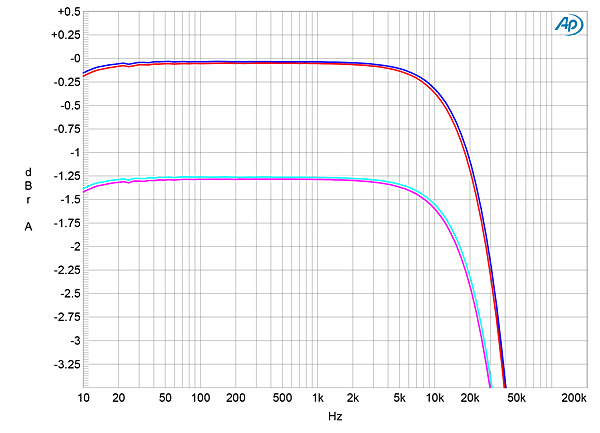
Fig.2 AVM PA 8.2, line input, balanced tube output, volume control = "99,5," frequency response at 1V into: 100k ohms (left channel blue, right red), 600 ohms (left cyan, right magenta) (0.25dB/vertical div.).
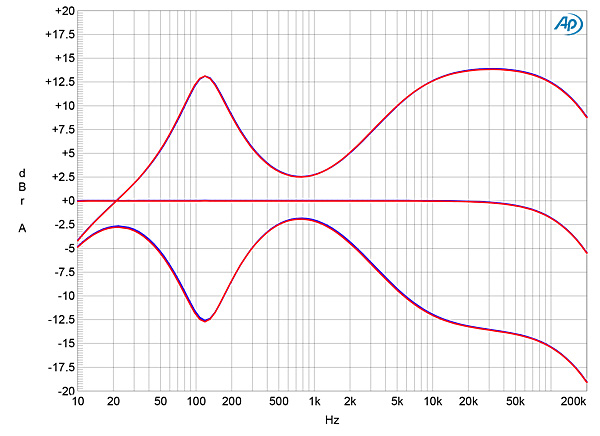
Fig.3 AVM PA 8.2, line input, balanced tube output, volume control = "80,0," frequency response with Bass and Treble controls set to ±7 (left channel blue, right red) (2.5dB/vertical div.).
The solid-state output module's channel separation was superb, at >120dB in both directions below 3kHz, and was still 105dB at 20kHz. The tubed output module's separation was about 30dB less across the audioband. The tubed module was also noisier. Fig.4 shows the low-frequency spectrum of the two modules' balanced outputs while reproducing a 1kHz tone at 2V into 100k ohms and the volume control set to its maximum. The solid-state module's spectrum (blue and red traces) was free from any power-supply–related spuriae, while the tubed spectrum is about 12dB higher in level, and also has some low-level, odd-order, supply-related spuriae at 180Hz, 300Hz, etc.
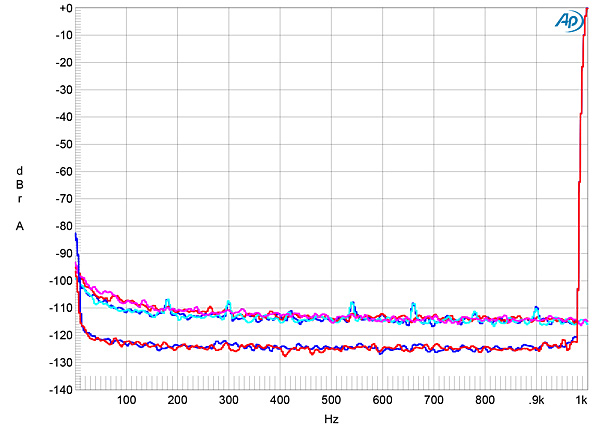
Fig.4 AVM PA 8.2, line input, spectrum of 1kHz sinewave, DC–1kHz, at 2V into 100k ohms: balanced solid-state output (left channel blue, right red), balanced tube output (left cyan, right magenta) (linear frequency scale).
At our usual definition of clipping (ie, when the percentage of THD+noise in the amplifier's output reaches 1%), the PA 8.2's solid-state module (fig.5, blue trace) clipped at 5.6V into 100kHz, but the downward slope of this trace below 3V indicates that this module's distortion is actually below the very low noise level. The tubed output module (fig.5, red trace) clips slightly higher in level, at 6.7V, and although the distortion is overall higher than the solid-state module's, and starts to rise out of the noise floor above 700mV, it remains very low in absolute terms. Both modules clipped at close to the same output levels into the punishing 600 ohm load. However, while the solid-state module offered astonishingly low distortion into 100k ohms up to 3kHz, with only a slight rise in the top octave (fig.6, blue and red traces), it performed less well into the very low 600 ohm load (cyan, magenta). Though the tubed module offered higher distortion into 100k ohms (around 0.01% across the band), the level of that distortion didn't rise into 600 ohms (fig.7).
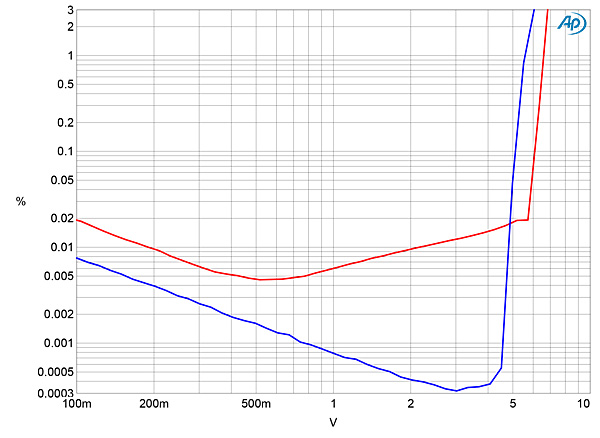
Fig.5 AVM PA 8.2, line input, distortion (%) vs 1kHz voltage into 100k ohms: balanced solid-state output (blue), balanced tube output (red).
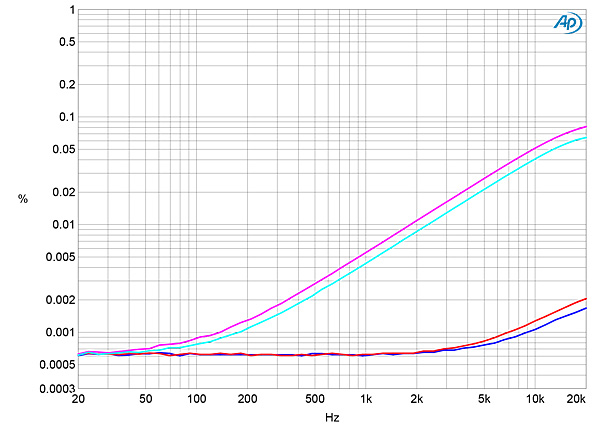
Fig.6 AVM PA 8.2, line input, balanced solid-state output, distortion (%) vs frequency at 3V into: 100k ohms (left channel blue, right red), 600 ohms (left cyan, right magenta).
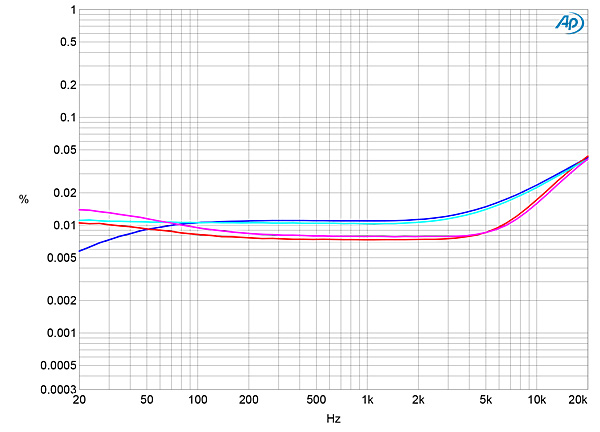
Fig.7 AVM PA 8.2, line input, balanced tube output, distortion (%) vs frequency at 3V into: 100k ohms (left channel blue, right red), 600 ohms (left cyan, right magenta).
The PA 8.2's solid-state distortion signature was primarily second harmonic in nature though vanishingly low in level, even into 600 ohms (fig.8). The second harmonic was also the highest in level with the tube module, with the third harmonic close in level to the second (fig.9). Intermodulation distortion was also extremely low, even with the tube module (fig.10), the difference component at 1kHz with an equal mix of 19 and 20kHz tones lying at –90dB (0.003%).
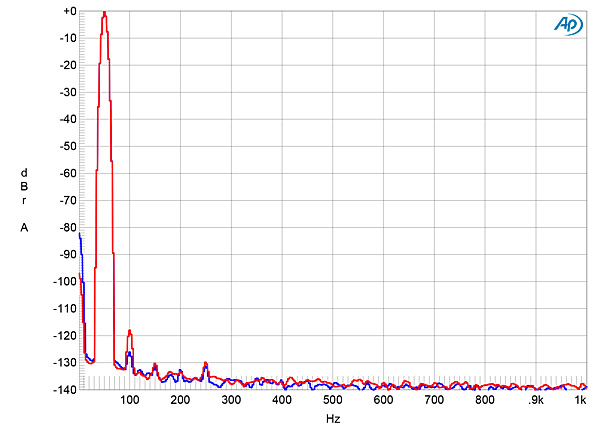
Fig.8 AVM PA 8.2, line input, balanced solid-state output, spectrum of 50Hz sinewave, DC–1kHz, at 2V into 600 ohms (left channel blue, right red; linear frequency scale).
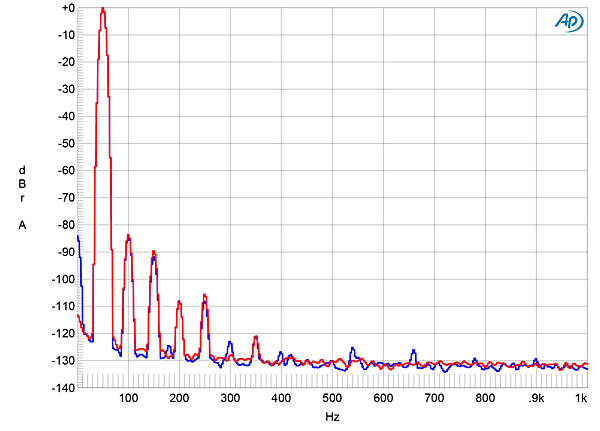
Fig.9 AVM PA 8.2, line input, balanced tube output, spectrum of 50Hz sinewave, DC–1kHz, at 2V into 100k ohms (left channel blue, right red; linear frequency scale).
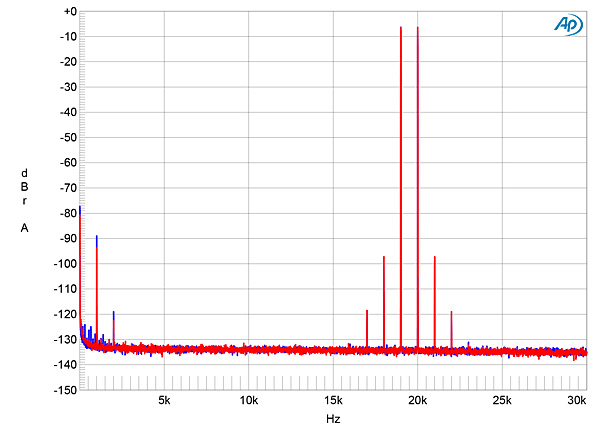
Fig.10 AVM PA 8.2, line input, balanced tube output, HF intermodulation spectrum, DC–30kHz, 19+20kHz at 2V peak into 100k ohms (left channel blue, right red; linear frequency scale).
Turning to the phono module, it preserved absolute polarity when set to MM, but inverted polarity when set to MC. The MM input impedance with the shunt capacitance set to 420pF was 44.5k ohms at 20Hz and 1kHz, dropping to 32.4k ohms at 20kHz. The MC input impedance was close to the values selected, 1k ohms measuring 979 ohms across the band; "330" measured 319 ohms, "150" 153 ohms, "110" 116 ohms, "75" 71 ohms, and "47" measured 46.5 ohms. The measured gain also closely tracked the settings, with ranges of approximately 43–52dB for MM and 63–72dB for MC.
The RIAA error (fig.11) was both superbly low and well matched between channels. The phono input's channel separation was very high, any crosstalk lying below –80dB, L–R, and –100dB, R–L. Set to MM and 43dB gain with the volume at its maximum, the wideband signal/noise ratio, ref. 1kHz at 5mV, was superb at 91dB, this improving to 101.5dB when A-weighted. The S/N ratio decreased as the gain was increased, as expected. The corresponding ratios for the MC setting were 69 and 76.2dB–this is a very quiet phono stage! For example, fig.12 shows the low-frequency spectrum with a 1kHz tone reproduced at 1V with the phono module set to MM and 43dB gain.
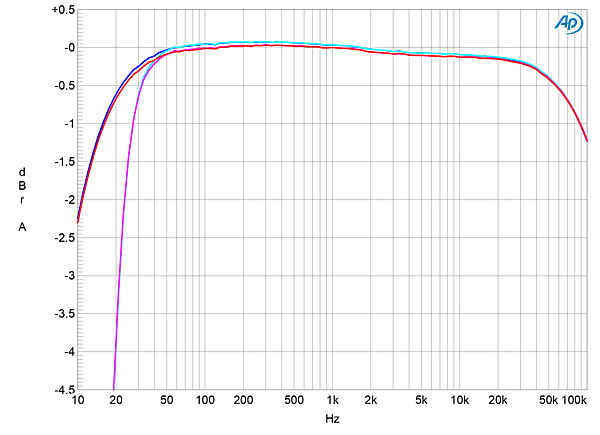
Fig.11 AVM PA 8.2, phono input, response with RIAA correction and with/without subsonic filter (0.5dB/vertical div.).
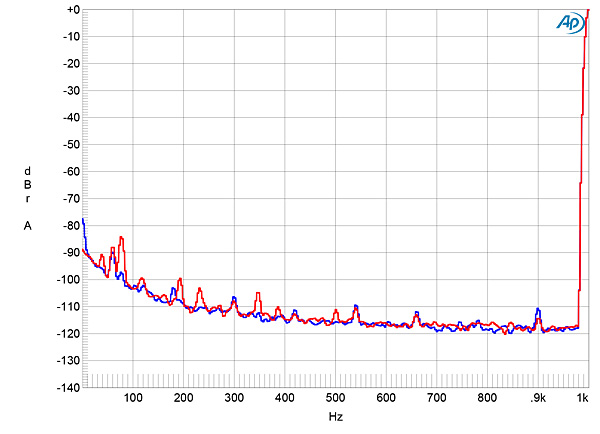
Fig.12 AVM PA 8.2, phono input, MM, 43dB gain, spectrum of 1kHz sinewave, DC–1kHz, at 1V into 100k ohms, balanced solid-state output (left channel blue, right red; linear frequency scale).
The phono input's overload margins were also very good, at 17dB at 20Hz, and 15.4dB at 1kHz and 20kHz. Both harmonic distortion (fig.13) and intermodulation distortion (fig.14) were extremely low, the former typically measuring close to 0.08%.
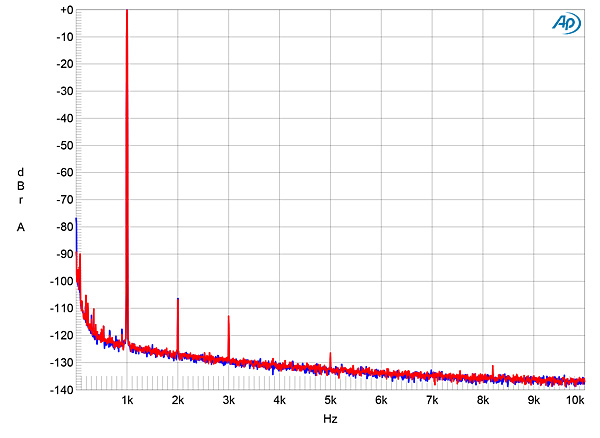
Fig.13 AVM PA 8.2, phono input, MM, 43dB gain, spectrum of 50Hz sinewave, DC–1kHz, at 2V into 100k ohms (left channel blue, right red; linear frequency scale).
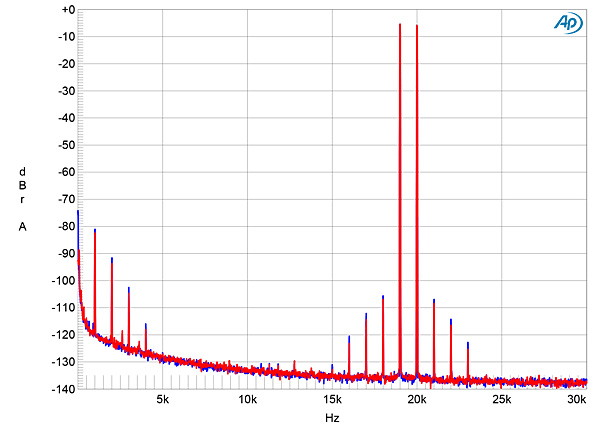
Fig.14 AVM PA 8.2, phono input, MM, 43dB gain, HF intermodulation spectrum, DC–30kHz, 19+20kHz at 2V peak into 100k ohms (left channel blue, right red; linear frequency scale).
Measuring the PA 8.2's S/PDIF inputs was problematic, as the digital input module was set to CNV (for sample-rate Conversion), and I couldn't see any way in the manual to switch it to Native, where the module would correctly track the incoming sample rate, even with digital input data present. (If there are no data present, the Menu buttons are inoperative.) I therefore used the Menu buttons to manually change the sample rate as necessary, and performed all measurements from the balanced solid-state outputs.
Apple's USB Prober utility identified the PA 8.2 as "AVM USB AUDIO" from "AVM" and confirmed that its USB port operated in the optimal isochronous asynchronous mode. Apple's AudioMIDI utility revealed that, via USB, the AVM accepted 16- and 24-bit integer data sampled at all rates up to 384kHz. Its coaxial and optical inputs locked to PCM datastreams with sample rates up to 192kHz.
The PA 8.2's digital inputs preserved absolute polarity. With its volume control set to "99,5," a 1kHz digital signal at –18dBFS resulted in the unbalanced, balanced, and headphone outputs clipping, which suggests that the digital module has much too much gain. I therefore continued the measurements with the volume control set to "80,0."
The Fast reconstruction filter's impulse response with 44.1kHz data (fig.15) indicates that this filter is a conventional linear-phase type, with time-symmetrical ringing to either side of the single sample at 0dBFS. The Slow filter's impulse response (fig.16) has just a single cycle of ringing before and after the single high sample. With 44.1kHz-sampled white noise (fig.17, red and magenta traces), the PA 8.2's response rolled off sharply above 20kHz, and reached full stopband suppression above the Nyquist frequency of 22.05kHz. An aliased image at 25kHz of a full-scale tone at 19.1kHz (blue and cyan traces) can therefore be seen but it lies at –112dB (0.00025%). The distortion harmonics of the 19.1kHz tone are visible above the ultrasonic noise floor, the third harmonic being the highest in level at –89dB (0.003%).
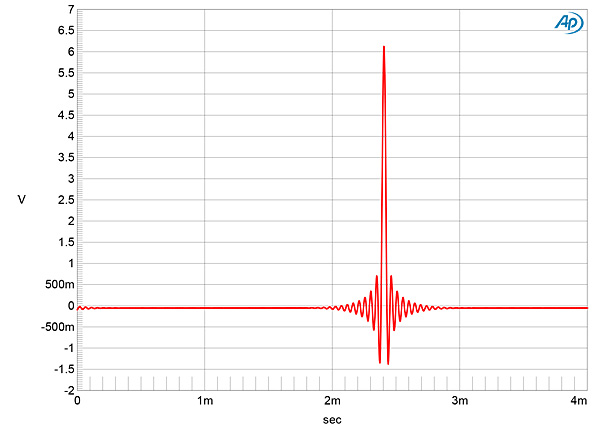
Fig.15 AVM PA 8.2, digital input, Fast filter, impulse response (one sample at 0dBFS, 44.1kHz sampling, 4ms time window).

Fig.16 AVM PA 8.2, digital input, Slow filter, impulse response (one sample at 0dBFS, 44.1kHz sampling, 4ms time window).
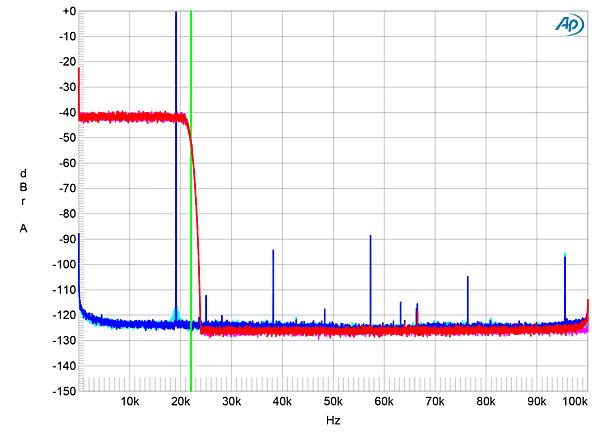
Fig.17 AVM PA 8.2, digital input, Fast filter, wideband spectrum of white noise at –4dBFS (left channel red, right magenta) and 19.1kHz tone at 0dBFS (left blue, right cyan), with data sampled at 44.1kHz (20dB/vertical div.).
As its name suggests, the Slow filter rolled off slowly above the audioband (fig.18), and the aliased 25kHz tone is suppressed by just 10dB. Fig.19 indicates that with 44.1kHz data (green and gray traces) the response reached –4dB at 20kHz. The Fast filter was flat to 20kHz at all sample rates (fig.20). When I increased the bit depth from 16 to 24 with a dithered 1kHz tone at –90dBFS (fig.21), the noise floor dropped by 24dB, meaning that the PA 8.2 offers 20 bits' worth of resolution, which is close to the state of the art. With undithered data representing a tone at exactly –90.31dBFS (fig.22), the three DC voltage levels described by the data were well resolved and the waveform was perfectly symmetrical. With undithered 24-bit data, the result was a clean sinewave (fig.23).
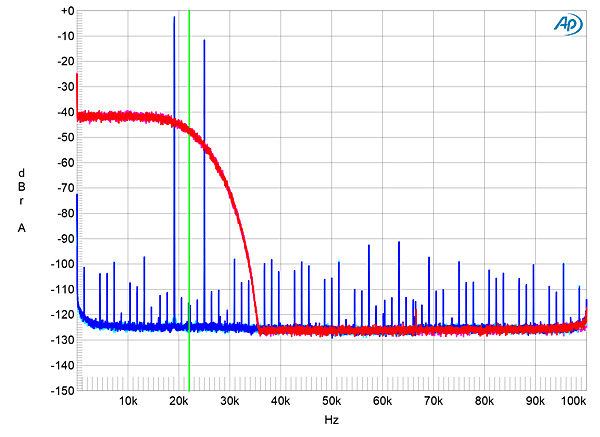
Fig.18 AVM PA 8.2, digital input, Slow filter, wideband spectrum of white noise at –4dBFS (left channel red, right magenta) and 19.1kHz tone at 0dBFS (left blue, right cyan), with data sampled at 44.1kHz (20dB/vertical div.).
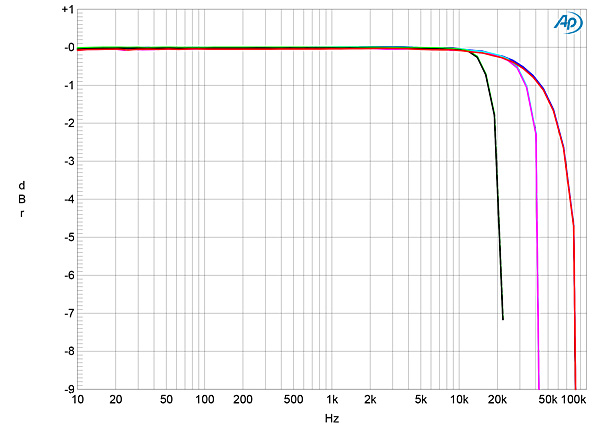
Fig.19 AVM PA 8.2, digital input, Slow filter, frequency response at –12dBFS into 100k ohms with data sampled at: 44.1kHz (left channel green, right gray), 96kHz (left cyan, right magenta), 192kHz (left blue, right red) (1dB/vertical div.).
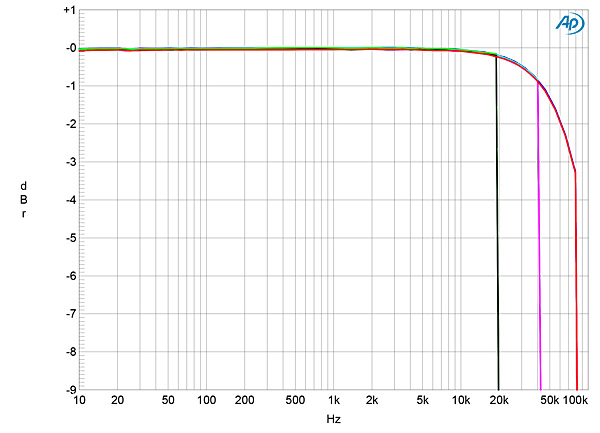
Fig.20 AVM PA 8.2, digital input, Fast filter, frequency response at –12dBFS into 100k ohms with data sampled at: 44.1kHz (left channel green, right gray), 96kHz (left cyan, right magenta), 192kHz (left blue, right red) (1dB/vertical div.).
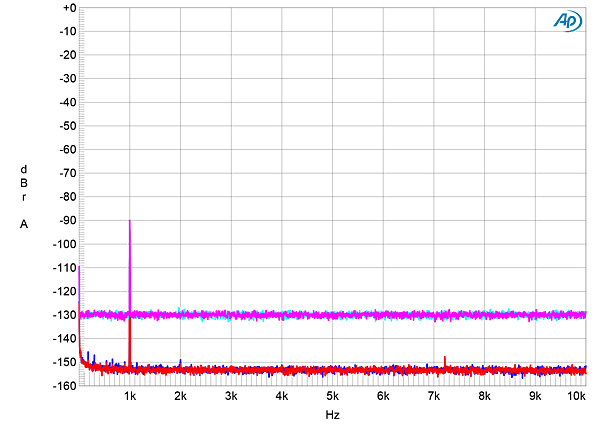
Fig.21 AVM PA 8.2, digital input, spectrum with noise and spuriae of dithered 1kHz tone at –90dBFS with: 16-bit data (left channel cyan, right magenta), 24-bit data (left blue, right red) (20dB/vertical div.).
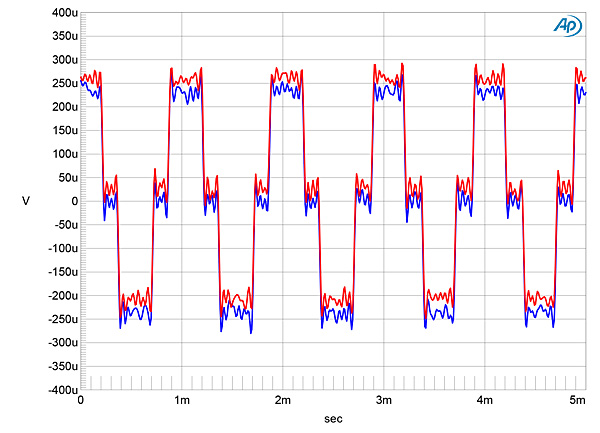
Fig.22 AVM PA 8.2, digital input, waveform of undithered 1kHz sinewave at –90.31dBFS, 16-bit TosLink data (left channel blue, right red).
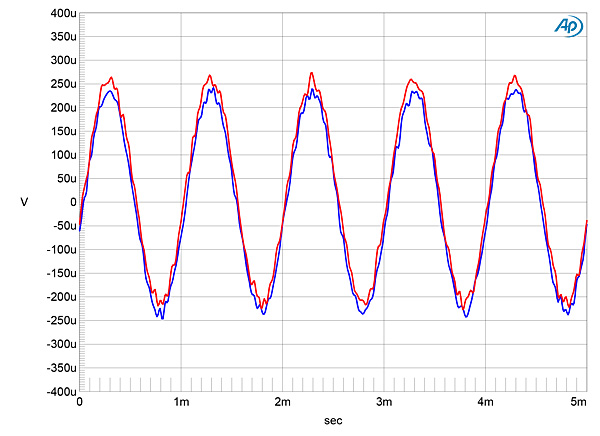
Fig.23 AVM PA 8.2, digital input, waveform of undithered 1kHz sinewave at –90.31dBFS, 24-bit TosLink data (left channel blue, right red).
The AVM's digital input module offered very low levels of distortion, although, as shown in fig.14, the third harmonic was predominant. There were also very low levels of intermodulation distortion via its digital inputs with both the Fast (fig.24) and Slow (fig.25) filters, though the Slow filter allowed the production of aliased images. Tested for the rejection of word-clock jitter with 16-bit J-Test data, both the S/PDIF and USB inputs behaved perfectly. The odd-order harmonics of the LSB-level, low-frequency squarewave are all at the correct levels, indicated by the sloping green line in fig.26, and no other sidebands can be seen.
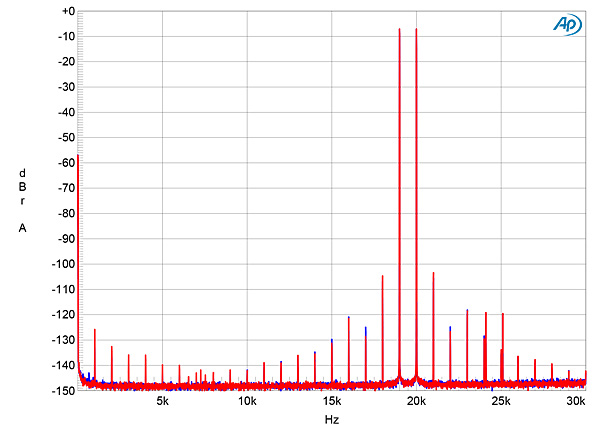
Fig.24 AVM PA 8.2, digital input, Fast filter, HF intermodulation spectrum, DC–30kHz, 19+20kHz at –1dBFS, 44.1kHz data (left channel blue, right red; linear frequency scale).
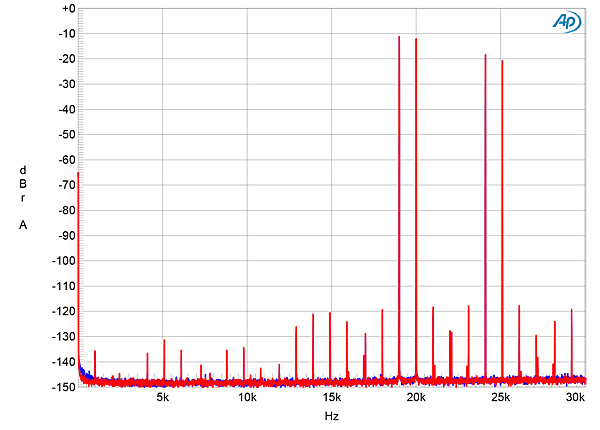
Fig.25 AVM PA 8.2, digital input, Slow filter, HF intermodulation spectrum, DC–30kHz, 19+20kHz at –3dBFS, 44.1kHz data (left channel blue, right red; linear frequency scale).
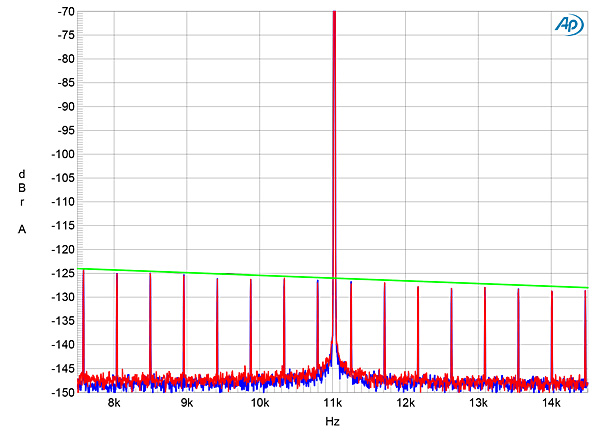
Fig.26 AVM PA 8.2, digital input, high-resolution jitter spectrum of analog output signal, 11.025kHz at –6dBFS, sampled at 44.1kHz with LSB toggled at 229Hz: 16-bit USB data (left channel blue, right red). Center frequency of trace, 11.025kHz; frequency range, ±3.5kHz.
Overall, AVM's Ovation PA 8.2 offers superb measured performance.—John Atkinson
- Log in or register to post comments




































